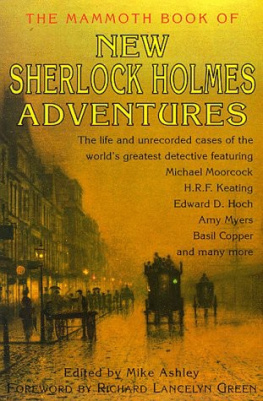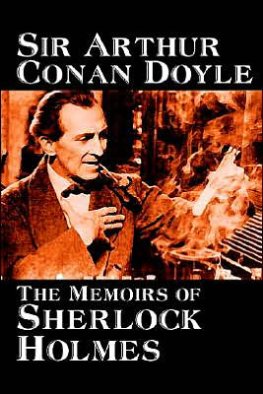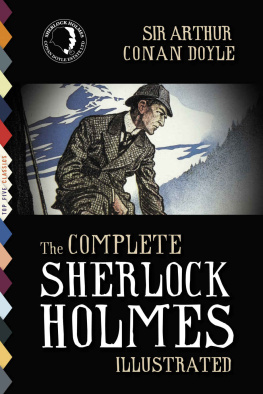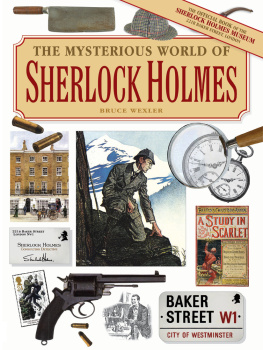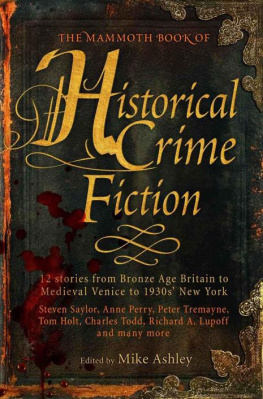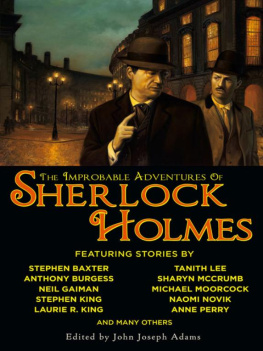The Mammoth Book of New Sherlock HolmesAdventures

THE MAMMOTH BOOK OF
NEW
SHERLOCK
HOLMES
ADVENTURES
EDITED BY MIKE ASHLEY

Constable & Robinson Ltd
3 The Lanchesters
162 Fulham Palace Road
London W6 9ER
www.constablerobinson.com
First published in the UK by Robinson Publishing, 1997
This revised and updated edition published by Robinson, an imprintof Constable & Robinson, 2009
Collection and editorial material Mike Ashley 1997, 2009
A copy of the British Library Cataloguing in Publication
Data is available from the British Library
UK ISBN 978-1-84529-926-2
1 3 5 7 9 10 8 6 4 2
First published in the United States in 2009 by Running Press BookPublishers
All rights reserved under the Pan-American and
International Copyright Conventions
9 8 7 6 5 4 3 2 1
Digit on the right indicates the number of this printing
US Library of Congress number: 2008942199
US ISBN 978 0 76243 626 2
Running Press Book Publishers
2300 Chestnut Street
Philadelphia, PA 19103-4371
Visit us on the web!
www.runningpress.com
Printed and bound in the EU
an ebookman scan
Mike Ashley is a full-time writer, editor and researcher withalmost a hundred books to his credit. He has compiled over fifty Mammoth Booksincluding The Mammoth Book of Extreme Science Fiction, The Mammoth Book ofExtreme Fantasy and The Mammoth Book of Perfect Crimes and ImpossibleMysteries. He has also written the biography of Algernon Blackwood,Starlight Man, and a comprehensive study The Mammoth Book of King Arthur. Helives in Kent with his wife and three cats and when he gets the time he likesto go for long walks.
Contents
Foreword by Richard Lancelyn Green
One ofthe most famous opening paragraphs in a Sherlock Holmes story is that found in"Thor Bridge" (which was first published in the 1920s). Dr Watsonsays: "Somewhere in the vaults of the bank of Cox & Co., at CharingCross, there is a travel-worn and battered tin dispatch-box with my name, JohnH. Watson, M.D., Late Indian Army, painted upon the lid. It is crammed withpapers, nearly all of which are records of cases to illustrate the curiousproblems which Mr Sherlock Holmes had at various times to examine."Readers had already been offered tantalizing details of many unrecorded casesin preceding stories, but this confirmed that he had a "long row ofyear-books which fill a shelf, and there are the dispatch cases filled withdocuments". He rightly called it "a perfect quarry for the student,not only of crime, but of the social and official scandals of the lateVictorian era". It is into these that the authors represented in thepresent volume have dipped.
The influence of Sherlock Holmes made itself felt within months ofthe publication of the first short stories in the Strand Magazine. Therewas plagiarism which achieved its apogee with Sexton Blake who had rooms inBaker Street, and there were rivals who knew they could succeed only by beingdifferent. The "Golden Age" of detective fiction was littered with astrange array of private inquiry agents who were fat, blind, Belgian or of theopposite sex. Yet for all their attempts at being different, they neverentirely escaped the shadow of Sherlock Holmes. As Scotland Yard haddiscovered, his longest shots invariably hit their mark, and even when he wasoutwitted, as he was by Irene Adler, his reputation was enhanced.
It is the art of a great writer to leave the reader anxious formore, and Dr Watson was such a writer. He often erred on the side of discretion,and he intrigued the reader because of his less than perfect grasp of detail.Where his knowledge failed he resorted to imagination and was not undulyconcerned when this led to contradictions and inconsistencies within the text.He introduced colour and variety and irrelevance, which added to the myth andgave the reader a picture which was sharp in its essentials, but blurred at theedges.
No reader has ever put down the stories believing that Watson hadsaid the last word on the subject. For some there was an irresistible urge toparody the style and to play with the name of Sherlock Holmes (which lendsitself well to mutations such as Shylock Bones, Sherluck Gnomes, PicklockHoles, or Sheerlecoq Omes).The parodies made fun of the contrasting characteristicsof Holmes and Watson, between the infallible brain which could distinguish 144types of cigarette ash or recognize clay and earth from the counties of England(something still denied to the most sophisticated computers of the latetwentieth century) and the obtuseness of the all-admiring friend.
The greatest scope for other writers lay in the unrecorded,unfathomed and unfinished cases. When Watson made it known that Holmes hadsurvived the struggle at the Reichenbach Falls, there were demands that heshould furnish the public with details of the cases which he had alreadymentioned, and he proceeded to do so with "The Second Stain" (towhich he had referred on two occasions). Even then there was an alternativeliterature provided by others, including major writers such as Bret Harte, andMark Twain (who introduced Holmes into his late novel, A Double-BarrelledDetective Story).
The early apocryphal works did not profess to be part of theoriginal "canon", for the concept only developed after Ronald Knoxhad elevated the study of Sherlock Holmes to new and rarefied heights in 1911with his famous satirical essay, "Studies in the Literature of SherlockHolmes". This gave impetus to the serious study of the stories and raisedthe possibility that there was not one but two authors (as had been suggestedin the writing of the Odyssey) or that Watson had described the earlycases as they happened, but had invented the later ones to satisfy publicdemand. The new scholarship opened the
way forothers to take up their pens to continue the saga, while remaining faithful totheir subject as had the story-tellers of old who created heroic deeds forAlexander the Great of which historians were previously unaware.
The apocryphal Sherlock Holmes story need not be a great detectivestory, but it has to be a convincing story of the great detective. Thecharacter is more important than the case. It is his method which appeals tothe reader. It is the special relationship with Dr Watson, who holds up amirror to nature and occasionally distorts the image to add glamour to thereflection. The additional stories should conform to the formula and yet shouldadd variety. The purist might prefer the seemingly insignificant trifle thatturns out to be important, and the humble and eccentric client often makes abetter entrance at Baker Street than the representatives of the reigning housesof Europe or the emissaries of the Pope. The introduction of historical figuressuch as Oscar Wilde or Jack the Ripper is not always advisable as it could besaid that they add an element of fiction to the self-contained world ofSherlock Holmes, and characters whose exploits have been documented by otherssometimes have difficulty crossing the threshold at Baker Street. Watson coulddescribe a case in which Sherlock Holmes outwitted Raffles, but it would not bethe Raffles who is known to us through the writings of his friend, BunnyManders. There again, there is no reason why Holmes's grandson should not apehis grandfather and form a working partnership with Dr Watson's granddaughter,but it is Dr Watson, and his work, who will always be most in demand. Whateverother cases remain in the battered dispatch box, readers are most anxious tohave details of the cases which are known to them by name and which were solvedby Sherlock Holmes.

